I took a peek at yesterday’s post again. It sounds a little dismal. It really wasn’t! There just wasn’t anything interesting to write about. I was focused on catching up on the blog. The pictures weren’t ready and I had nothing written. I suppose I could have researched the origin of celebrating the New Year . . .
It’s moving day. We’d both like to stay here longer, but it’s just not possible this year. Plus, it’s gonna be way too cold for the coach to stay. It’s supposed to be in the low 20’s for the rest of the week. Glad our heat works good!
I went out this morning to do a load of laundry. Man, is it cold!!! It would be OK if not for the wind. Honestly, I don’t mind the brisk temps. I find it invigorating. One more thing to add to my “she’s weird” list.
I couldn’t stand it. I never should have mentioned the origins of New Year’s celebrations. I copied this from the History Channel website. There’s some interesting things in here!
The earliest recorded festivities in honor of a new year’s arrival date back some 4,000 years to ancient Babylon. For the Babylonians, the first new moon following the vernal equinox—the day in late March with an equal amount of sunlight and darkness—heralded the start of a new year. They marked the occasion with a massive religious festival called Akitu (derived from the Sumerian word for barley, which was cut in the spring) that involved a different ritual on each of its 11 days. In addition to the new year, Atiku celebrated the mythical victory of the Babylonian sky god Marduk over the evil sea goddess Tiamat and served an important political purpose: It was during this time that a new king was crowned or that the current ruler’s divine mandate was symbolically renewed.
Did You Know?
In order to realign the Roman calendar with the sun, Julius Caesar had to add 90 extra days to the year 46 B.C. when he introduced his new Julian calendar.
Throughout antiquity, civilizations around the world developed increasingly sophisticated calendars, typically pinning the first day of the year to an agricultural or astronomical event. In Egypt, for instance, the year began with the annual flooding of the Nile, which coincided with the rising of the star Sirius. The first day of the Chinese new year, meanwhile, occurred with the second new moon after the winter solstice.
JANUARY 1 BECOMES NEW YEAR’S DAY
The early Roman calendar consisted of 10 months and 304 days, with each new year beginning at the vernal equinox; according to tradition, it was created by Romulus, the founder of Rome, in the eighth century B.C. A later king, Numa Pompilius, is credited with adding the months of Januarius and Februarius. Over the centuries, the calendar fell out of sync with the sun, and in 46 B.C. the emperor Julius Caesar decided to solve the problem by consulting with the most prominent astronomers and mathematicians of his time. He introduced the Julian calendar, which closely resembles the more modern Gregorian calendar that most countries around the world use today.
As part of his reform, Caesar instituted January 1 as the first day of the year, partly to honor the month’s namesake: Janus, the Roman god of beginnings, whose two faces allowed him to look back into the past and forward into the future. Romans celebrated by offering sacrifices to Janus, exchanging gifts with one another, decorating their homes with laurel branches and attending raucous parties. In medieval Europe, Christian leaders temporarily replaced January 1 as the first of the year with days carrying more religious significance, such as December 25 (the anniversary of Jesus’ birth) and March 25 (the Feast of the Annunciation); Pope Gregory XIII reestablished January 1 as New Year’s Day in 1582.
NEW YEAR’S TRADITIONS
In many countries, New Year’s celebrations begin on the evening of December 31—New Year’s Eve—and continue into the early hours of January 1. Revelers often enjoy meals and snacks thought to bestow good luck for the coming year. In Spain and several other Spanish-speaking countries, people bolt down a dozen grapes-symbolizing their hopes for the months ahead-right before midnight. In many parts of the world, traditional New Year’s dishes feature legumes, which are thought to resemble coins and herald future financial success; examples include lentils in Italy and black-eyed peas in the southern United States. Because pigs represent progress and prosperity in some cultures, pork appears on the New Year’s Eve table in Cuba, Austria, Hungary, Portugal and other countries. Ring-shaped cakes and pastries, a sign that the year has come full circle, round out the feast in the Netherlands, Mexico, Greece and elsewhere. In Sweden and Norway, meanwhile, rice pudding with an almond hidden inside is served on New Year’s Eve; it is said that whoever finds the nut can expect 12 months of good fortune.
Other customs that are common worldwide include watching fireworks and singing songs to welcome the new year, including the ever-popular “Auld Lang Syne” in many English-speaking countries. The practice of making resolutions for the new year is thought to have first caught on among the ancient Babylonians, who made promises in order to earn the favor of the gods and start the year off on the right foot. (They would reportedly vow to pay off debts and return borrowed farm equipment.)
In the United States, the most iconic New Year’s tradition is the dropping of a giant ball in New York City’s Times Square at the stroke of midnight. Millions of people around the world watch the event, which has taken place almost every year since 1907. Over time, the ball itself has ballooned from a 700-pound iron-and-wood orb to a brightly patterned sphere 12 feet in diameter and weighing in at nearly 12,000 pounds. Various towns and cities across America have developed their own versions of the Times Square ritual, organizing public drops of items ranging from pickles (Dillsburg, Pennsylvania) to possums (Tallapoosa, Georgia) at midnight on New Year’s Eve.
We also heard on the news around here about dropping a giant peach in Atlanta (it’s Georgia!) and an Indy car (in where else? Indianapolis!).
So that got me thinking too. What are some of the more unusual ‘drops’ done to mark the turn of the annual calendar? Here’s a top 25 list I found on mentalfloss.com
- Giant Peep – Bethlehem, PA (it’s where they’re made)
- 3’ Ceramic Flea – Eastover, NC
- 600# Moon Pie – Mobile, AL
- A REAL (although dead) Carp – Prairie Du Chien, Wisconsin
- Olive (into a giant martini glass) – Bartlesville, Oklahoma
- 800# Beach Ball – Panama City Beach, Florida
- A Sardine (and a Maple Leaf to honor Canada), Eastport, Maine
- A Wrench – Mechanicsburg, PA
- A Duck Decoy – Havre De Grace, Maryland
- Giant Peach (I already mentioned this one) – Atlanta, GA
- Pinecone – Flagstaff, AZ
- Apple – Manhattan, Kansas
- Large Chunk of Sartori Cheese – Plymouth, Wisconsin
- A Drag Queen in an oversized Red High Heel, a Conch Shell (at Sloppy Joe’s) and a Pirate Wench (at Schooner Wharf Bar) – Key West, Florida (They really go all out here!)
- 200# of Bologna – Lebanon, PA
- Marshall the Muskrat (stuffed version) – Princess Anne, Maryland
- A 3’ Pickle – Mt. Olive, NC (Shouldn’t they be the ones with the Olive??)
- 10’, 1250# copper and steel Acorn – Raleigh, NC
- A Potato – Boise, Idaho
- A 5’ Wooden Key – Fredrick, Maryland (home of Francis Scott KEY. 😊)
- 5’ x 8’ Bunch of Grapes – Temecula, CA
- A Music Note – Nashville, TN
- A Hog made of LED Lights – Fayetteville, Arkansas
- A 35’ Neon Orange – Miami, FL
- A Watermelon Ball that opens when it gets to the top and drops 12 real Watermelons – Vincennes, Indiana
Had enough trivia? I’m done. Gotta go fetch my laundry and start packing up! I’d say Blaine would leave without me, but as long as I stay inside, that can’t happen! 😊
The big news is still – it’s COLD! But according to The Weather Channel, it’s cold everywhere. They keep calling it ‘Frozen America’! Down here in Georgia, they just don’t know what to do with it. The news talks of little else. They told us today that Charleston, SC not only had record low temps, but they’re expecting 3” of snow! They’ll be shut down for a week. 😊
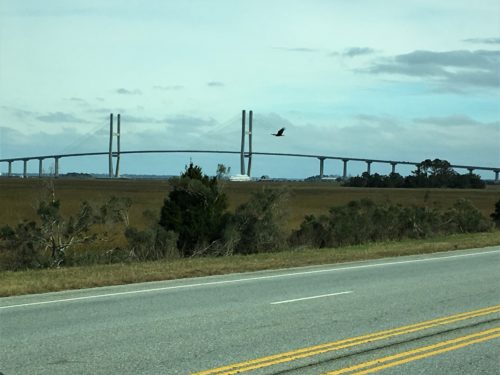
Approaching Jekyll Island.
There’s that darn bridge design again!


It’s hard to get good pictures when you’re riding in a house. : )

Here in Jekyll Island, people are wearing so many layers (at 35 degrees), they look like little kids trying to move in their snow suits! I, on the other hand, was mostly wearing a long-sleeved shirt and a sweatshirt.
Until we went out to the beach.
We think the wind chill was about 20. I was wearing my hiking tennis shoes, which are canvas and the wind was whipping through them! Brrrr!

This is the first beach we visited today.
Don’t know what it was, except not worth sticking around in the cold!

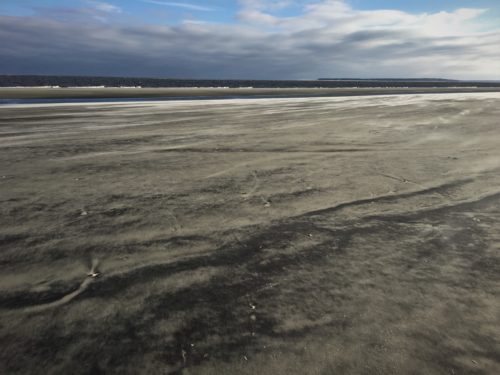
See the white stuff near the top of the pictures?
That’s sand flying across the beach!
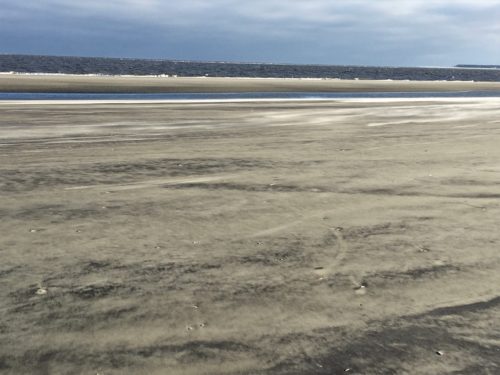
They call this Glory Beach because Hollywood used it to film parts of the movie “Glory”.
If you haven’t seen it – you should!
Matthew Broderick, early Denzel Washington and plenty of others!
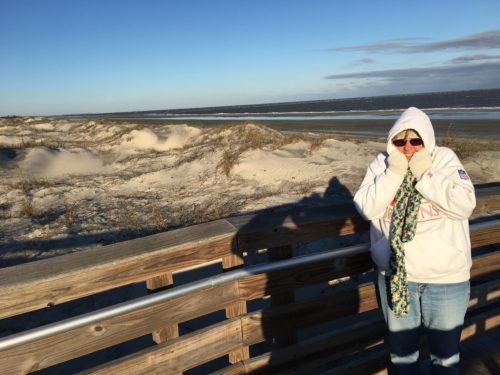
Great Dunes Beach


By the way – this is the Atlantic Ocean
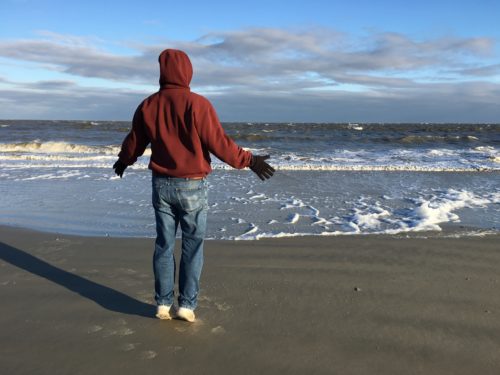
He wasn’t trying to fly, he was doing jumping jacks to try to stay warm! : )
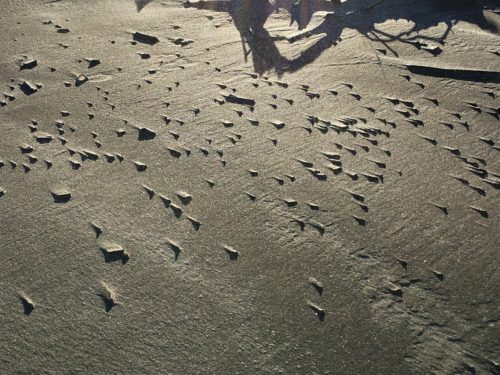
I’ve never seen sand make this kind of formation.
Not sure what caused it.

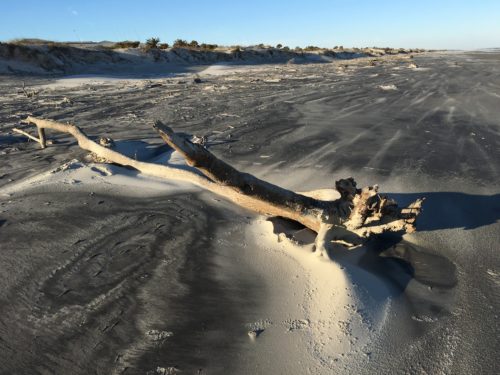
Last year on this date, it was 82 degrees!
They’re telling everyone to stay in and hunker down if possible tomorrow. They’re expecting an ice storm.
Stay tuned.
TOTAL MILES = .5 (but half that was walking into the wind, so I’m giving us .75)
ANNUAL TOTAL = .75
